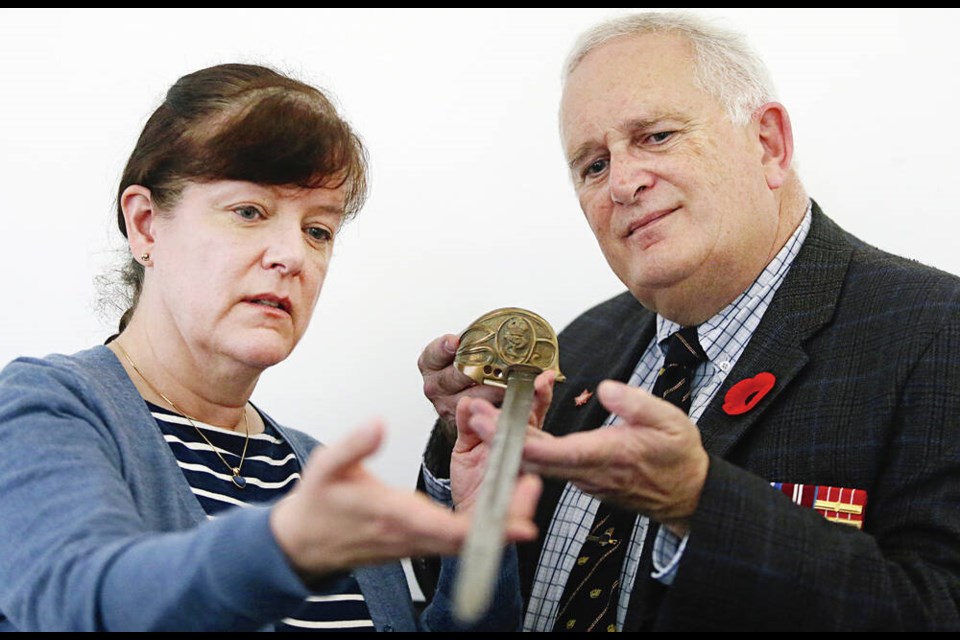A corroded sword linked to a torpedoed Royal Navy warship — and gathering dust in a Victoria basement for more than 40 years — is going on display at the CFB Esquimalt Naval Museum today and will eventually find its way home to the United Kingdom.
James Atwood, a retired Sea King helicopter pilot, received the sword from his English grandfather as a gift in the early 1980s.
And the 38-inch blade had an incredible story.
Grandpa John (Jack) Hilton Louis, who spent five years fighting in the Second World War and retired as a major, got the sword with leather strap and scabbard from a professional diver decades earlier who had recovered it from the wreckage site of HMS Royal Oak at Scapa Flow in the Orkney Islands off the north tip of Scotland.
The battleship had been involved in the famous First World War naval battle of Jutland in 1916, but was an early casualty of the Second World War when a German U-boat slipped through a gap in anti-submarine defences and drilled three torpedoes into the ship’s starboard side on Oct. 14, 1939.
Royal Oak was caught by surprise with its watertight doors still open and a fireball tearing through its decks. It capsized and sank in 13 minutes.
LCdr RCN (Ret’d) Paul Seguna, a volunteer researcher for the CFB Esquimalt Naval and Military Museum, said of the 1,260 sailors on Royal Oak that night, 835 died — among them Peter Grosvenor Piddington from a well-known Esquimalt family. He was a 20-year-old midshipman serving in the Royal Navy and the son of Major Arthur Piddington and Helen Piddington (née Wychbury) who had attended Lampson Street, Shawnigan Lake and Esquimalt schools, and Victoria College.
Piddington was also a member of the Rainbow Sea Cadet Corps for several years before joining the Royal Navy in 1936.
Atwood had no idea the sword from the Royal Oak had another connection to Victoria, but after hearing about the research on the ship and the local sailor who died aboard, he thought that the relic should come out of his basement and be put on display.
He said he introduced Seguna to the sword his grandfather gave him during an evening over supper, and all of the history started unfolding.
Given its potential historical significance, Atwood decided that the sword should be repatriated to the United Kingdom to join other Royal Oak artifacts in the collection of the Scapa Flow Museum.
“I’m happy it’s going to a place where some folks will find it meaningful,” Atwood, a third-generation military man, said this week.
Seguna said Scapa Flow Museum has expressed an interest in acquiring the sword based on the supporting background information. He said U.K. government authorities in Canada have also been made aware of the sword and the intention to see it repatriated to the museum.
In the interim, until repatriation arrangements are finalized, Seguna said the intent is to exhibit the sword at the CFB Esquimalt Naval and Military museum during the Remembrance Day observation in memory of Midshipman Piddington.
The museum on the Esquimalt base is also displaying a lithograph of an original watercolour painting related to a visit by Royal Navy battlecruiser HMS Hood to Victoria’s Ogden Point and Â鶹´«Ã½Ó³»in 1925.
Hood was lost on May 24, 1941, in a battle with the German battleship Bismarck and heavy cruiser Prinz Eugen. The sinking in the North Atlantic’s Denmark Strait claimed 1,418 lives with only three survivors.
Three midshipmen who died had an Island connection — Thomas Norman Kemp Beard, 20, of Victoria, had attended Shawnigan Lake School prior to joining the RCN as a cadet; Francis Llewelyn Lloyd Jones, also 20, was born in Victoria; and Christopher John Birdwood Norman, 19, was born in Duncan and attended Victoria College.



